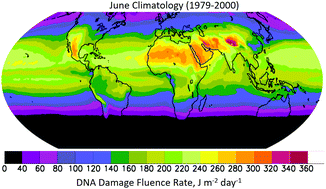当前位置:
X-MOL 学术
›
Photochem. Photobiol. Sci.
›
论文详情
Our official English website, www.x-mol.net, welcomes your feedback! (Note: you will need to create a separate account there.)
Solar UV radiation and microbial life in the atmosphere
Photochemical & Photobiological Sciences ( IF 3.1 ) Pub Date : 2018-06-29 , DOI: 10.1039/c7pp00407a Sasha Madronich 1, 2, 3 , Lars Olof Björn 4, 5, 6, 7 , Richard L. McKenzie 8, 9, 10
Photochemical & Photobiological Sciences ( IF 3.1 ) Pub Date : 2018-06-29 , DOI: 10.1039/c7pp00407a Sasha Madronich 1, 2, 3 , Lars Olof Björn 4, 5, 6, 7 , Richard L. McKenzie 8, 9, 10
Affiliation

|
Many microorganisms are alive while suspended in the atmosphere, and some seem to be metabolically active during their time there. One of the most important factors threatening their life and activity is solar ultraviolet (UV) radiation. Quantitative understanding of the spatial and temporal survival patterns in the atmosphere, and of the ultimate deposition of microbes to the surface, is limited by a number factors some of which are discussed here. These include consideration of appropriate spectral sensitivity functions for biological damage (e.g. inactivation), and the estimation of UV radiation impingent on a microorganism suspended in the atmosphere. We show that for several bacteria (E. coli, S. typhimurium, and P. acnes) the inactivation rates correlate well with irradiances weighted by the DNA damage spectrum in the UV-B spectral range, but when these organisms show significant UV-A (or visible) sensitivities, the correlations become clearly non-linear. The existence of these correlations enables the use of a single spectrum (here DNA damage) as a proxy for sensitivity spectra of other biological effects, but with some caution when the correlations are strongly non-linear. The radiative quantity relevant to the UV exposure of a suspended particle is the fluence rate at an altitude above ground, while down-welling irradiance at ground-level is the quantity most commonly measured or estimated in satellite-derived climatologies. Using a radiative transfer model that computes both quantities, we developed a simple parameterization to exploit the much larger irradiance data bases to estimate fluence rates, and present the first fluence-rate based climatology of DNA-damaging UV radiation in the atmosphere. The estimation of fluence rates in the presence of clouds remains a particularly challenging problem. Here we note that both reductions and enhancements in the UV radiation field are possible, depending mainly on cloud optical geometry and prevailing solar zenith angles. These complex effects need to be included in model simulations of the atmospheric life cycle of the organisms.
中文翻译:

太阳紫外线辐射和大气中的微生物生命
许多微生物悬浮在大气中时仍然存活,其中一些似乎在它们的体内具有代谢活性。威胁其生命和活动的最重要因素之一是太阳紫外线(UV)辐射。对大气中空间和时间生存模式以及微生物最终沉积到地表的定量理解受到许多因素的限制,此处讨论了其中的一些因素。这些措施包括考虑对生物损害(例如灭活)使用适当的光谱敏感度函数,以及估算悬浮在大气中的微生物所受到的紫外线辐射。我们表明,对于几种细菌(大肠杆菌,鼠伤寒沙门氏菌和痤疮丙酸杆菌灭活率与UV-B光谱范围内的DNA损伤光谱加权的辐射有很好的相关性,但是当这些生物体表现出显着的UV-A(或可见)敏感性时,相关性显然变得非线性。这些相关性的存在使得可以使用单个光谱(此处为DNA损伤)作为其他生物学效应敏感性光谱的替代物,但是当相关性是强烈非线性时,请谨慎行事。与悬浮粒子的紫外线照射相关的辐射量是在地面以上高度的注量率,而地面水平的井下辐照度是在源自卫星的气候中最常测量或估算的量。使用同时计算两个数量的辐射传递模型,我们开发了一个简单的参数化方法,以利用更大的辐照度数据库估算注量率,并提出了第一个基于注量率的大气中破坏DNA的UV辐射气候学。在云的存在下,注量率的估计仍然是一个特别具有挑战性的问题。在这里,我们注意到减少和增强紫外线辐射场都是可能的,这主要取决于云的光学几何形状和主要的太阳天顶角。这些复杂的影响需要包括在生物的大气生命周期的模型模拟中。在这里,我们注意到减少和增强紫外线辐射场都是可能的,这主要取决于云的光学几何形状和主要的太阳天顶角。这些复杂的影响需要包括在生物的大气生命周期的模型模拟中。在这里,我们注意到减少和增强紫外线辐射场都是可能的,这主要取决于云的光学几何形状和主要的太阳天顶角。这些复杂的影响需要包括在生物的大气生命周期的模型模拟中。
更新日期:2018-12-05
中文翻译:

太阳紫外线辐射和大气中的微生物生命
许多微生物悬浮在大气中时仍然存活,其中一些似乎在它们的体内具有代谢活性。威胁其生命和活动的最重要因素之一是太阳紫外线(UV)辐射。对大气中空间和时间生存模式以及微生物最终沉积到地表的定量理解受到许多因素的限制,此处讨论了其中的一些因素。这些措施包括考虑对生物损害(例如灭活)使用适当的光谱敏感度函数,以及估算悬浮在大气中的微生物所受到的紫外线辐射。我们表明,对于几种细菌(大肠杆菌,鼠伤寒沙门氏菌和痤疮丙酸杆菌灭活率与UV-B光谱范围内的DNA损伤光谱加权的辐射有很好的相关性,但是当这些生物体表现出显着的UV-A(或可见)敏感性时,相关性显然变得非线性。这些相关性的存在使得可以使用单个光谱(此处为DNA损伤)作为其他生物学效应敏感性光谱的替代物,但是当相关性是强烈非线性时,请谨慎行事。与悬浮粒子的紫外线照射相关的辐射量是在地面以上高度的注量率,而地面水平的井下辐照度是在源自卫星的气候中最常测量或估算的量。使用同时计算两个数量的辐射传递模型,我们开发了一个简单的参数化方法,以利用更大的辐照度数据库估算注量率,并提出了第一个基于注量率的大气中破坏DNA的UV辐射气候学。在云的存在下,注量率的估计仍然是一个特别具有挑战性的问题。在这里,我们注意到减少和增强紫外线辐射场都是可能的,这主要取决于云的光学几何形状和主要的太阳天顶角。这些复杂的影响需要包括在生物的大气生命周期的模型模拟中。在这里,我们注意到减少和增强紫外线辐射场都是可能的,这主要取决于云的光学几何形状和主要的太阳天顶角。这些复杂的影响需要包括在生物的大气生命周期的模型模拟中。在这里,我们注意到减少和增强紫外线辐射场都是可能的,这主要取决于云的光学几何形状和主要的太阳天顶角。这些复杂的影响需要包括在生物的大气生命周期的模型模拟中。



























 京公网安备 11010802027423号
京公网安备 11010802027423号